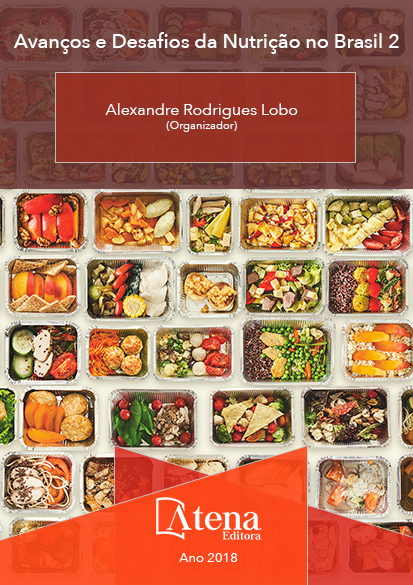
CORRELAÇÃO DE INDICADORES ANTROPOMÉTRICOS EM FUNCIONÁRIOS DO SETOR HOTELEIRO
Nas últimas décadas, as mudanças
nos padrões alimentares e nutricionais da
população tem sido uma das principais
características da sociedade moderna.
Essas mudanças levam à chamada transição
nutricional, caracterizada pelo aumento na
prevalência de sobrepeso e obesidade e redução
da desnutrição. De maneira preocupante, a
obesidade está relacionada ao desenvolvimento
de variadas comorbidades que afetam a
qualidade de vida e exercem influência direta
sobre a capacidade de trabalho do indivíduo,
tendo como destaque o desenvolvimento das
Doenças Crônicas Não Transmissíveis (DCNT).
Para a vigilância dos fatores de risco das DCNT,
a Organização Mundial de Saúde (OMS) indica
o uso da antropometria. Portanto, objetivo do
estudo foi analisar o Índice de Massa Corporal
(IMC), Circunferência da Cintura (CC) e sua
correlação em funcionários de um hotel de luxo
na cidade de Fortaleza/CE. Foram avaliados
31 funcionários de um hotel na cidade de
Fortaleza/CE. Todos os participantes do estudo
assinaram um termo de consentimento livre
e esclarecido. Foram realizadas medidas
antropométricas (peso, altura e circunferência
da cintura). Dos 31 avaliados, 45,16% eram
homens e 54,84% mulheres, com idade média
de aproximadamente 34 anos. Com o resultado
obtido no perfil antropométrico, detectou-se
que 67,7% dos funcionários apresentaram
excesso de peso, sendo 45,1% com sobrepeso
e 22,6% com obesidade, apresentando IMC
médio de 27,05 kg/m²; quanto à circunferência
abdominal, observou-se que 54,8% dos
participantes estavam com valores acima do
considerado normal, sinalizando maior risco
para o aparecimento de doenças crônicas
não transmissíveis, como HAS, DM e doenças
cardiovasculares. Quanto à correlação entre
IMC e CC, os resultados evidenciaram uma forte
associação e estatisticamente significante nos gêneros estudados, com rs = 0,9044 e rs
= 0,8330, para o sexo feminino e masculino, respectivamente. Para toda a população
em estudo, rs = 0,8250. Logo, a maioria dos participantes do grupo avaliado possuía
valores elevados de IMC e CC, além de uma forte correlação positiva entre essas
medidas, evidenciando a mudança de perfil nutricional da população e destacando a
importância de intervenção nutricional.
CORRELAÇÃO DE INDICADORES ANTROPOMÉTRICOS EM FUNCIONÁRIOS DO SETOR HOTELEIRO
-
DOI: 10.22533/at.ed.94918021210
-
Palavras-chave: Índice de Massa Corporal; Avaliação Nutricional; Hotelaria.
-
Keywords: Nutrition; Body Mass Index; Nutritional Assessment; Hospitality.
-
Abstract:
In recent decades, changes in the dietary and nutritional patterns of
the population have been a major feature of modern society. These changes lead to
the so-called nutritional transition characterized by an increase in the prevalence of
overweight and obesity and reduction of malnutrition. Obviously, obesity is related to
the development of a variety of comorbidities that affect quality of life and have a direct
influence on the individual’s work capacity, with emphasis on the development of chronic
noncommunicable diseases (CNCDs). For monitoring the risk factors of CNCD, the
World Health Organization (WHO) indicates the use of anthropometry. Therefore, the
objective of the study was to analyze the Body Mass Index (BMI), Waist Circumference
(WC) and its correlation in a group of employees of a Hotel in the city of Fortaleza
/ CE. We evaluated 31 employees of a Hotel in the city of Fortaleza / CE. All study
participants signed a free and informed consent form. Anthropometric measurements
were performed (weight, height and waist circumference). Of the 31 evaluated, 45.16%
were men and 54.84% women, with a mean age of approximately 34 years. With the
result obtained in the anthropometric profile, 67.7% of the employees were overweight,
45.1% were overweight and 22.6% were obese, with a mean BMI of 27.05 kg / m²;
Regarding abdominal circumference, it was observed that 54.8% of the participants had
values above what was considered normal, indicating a higher risk for the appearance
of chronic non-communicable diseases, such as hypertension, DM and cardiovascular
diseases. Regarding the correlation between BMI and CC, the results showed a strong
and statistically significant association in the studied genres, with rs = 0.9044 and rs
= 0.8330, respectively, for females and males. For the study population, rs = 0.8250.
Therefore, the majority of the participants in the evaluated group had high BMI and
WC, and a strong positive correlation between these measures, evidencing the change
in the nutritional profile of the population and highlighting the importance of nutritional
intervention.
-
Número de páginas: 15
- Clarice Maria Araújo Chagas Vergara


